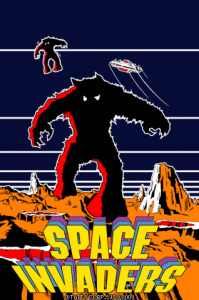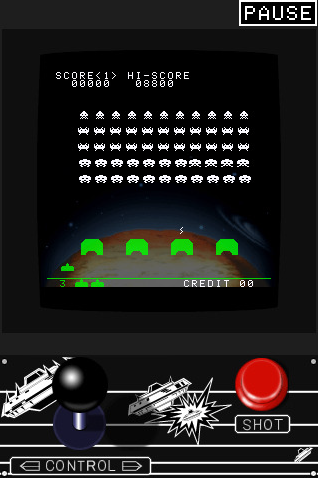 Taito has released an official iPhone version of Tomohiro Nishikado’s 1978 arcade classic Space Invaders [link] through the iTunes App Store.
Taito has released an official iPhone version of Tomohiro Nishikado’s 1978 arcade classic Space Invaders [link] through the iTunes App Store.
For those who may be unfamiliar with the game, we recommend that you close your browser window and go find a different website to read. Actually, that was a joke. Sort of…
Rated the top video game of all time by Guinness World Records, Space Invaders is the father of all 2D shooters. It was released in Japan by Taito in 1978 to such success that it caused a temporary national shortage of 100-yen coins. It was later licensed by Bally Midway and released in the United States. By 2007 the game had earned Taito $500 million in revenue. Space Invaders is the classic of classics.
As Wikipedia describes the game,
Space Invaders is a two-dimensional, fixed shooter game in which the player controls a laser cannon by moving it horizontally across the bottom of the screen and firing at aliens. The aim is to defeat five rows of eleven aliens—some versions feature different numbers—that move horizontally back and forth across the screen as they descend towards the bottom of the screen. The player defeats an alien, and earns points, by shooting it with the laser cannon. As more aliens are defeated, the aliens’ movement and the game’s heartbeat sound both speed up. Defeating the aliens brings another wave that is more difficult; a cycle which can continue indefinitely.
The aliens attempt to destroy the cannon by firing at it while they are approaching the bottom of the screen. If they reach the bottom, the alien invasion is successful and the game ends. A special “mystery ship" will sometimes move across the top of the screen and will award bonus points if destroyed. The laser cannon is partially protected by several stationary defense bunkers—the number varies by version—that are gradually destroyed by alien fire.
The iPhone version exactly duplicates the gameplay of the arcade original. Originally a monochrome game, Space Invaders received a number of mild graphical upgrades through its life–all are represented in this version: true monochrome, “color" by way of a simulation of the cellophane overlay that first brought color to the game in the arcades, actual color, and a planetscape background (that in the arcade was achieved via mirrored display and cardboard backsheet). The game board is a pixel perfect representation of the arcade display and, being of a lower resolution than the iPhone’s screen, is surrounded by a dark frame with a control board at the bottom of the screen. Graphics can be magnified to 120% and 140% for easier viewing.

The game features an on-screen fire button with three options for controlling the laser cannon: left / right buttons that can be tapped, a control stick that can be “dragged," and tilt control utilizing the iPhone’s accelerometers.
Several additional touches have been rolled into the iPhone version. A Help section discusses the controls, how to play, and various tips and techniques used by the pros. A Secret Files section contains photos of early promotional fliers, original character pencil sketches, even sections of the game’s assembly language source listing.
It’s great to see an official version of this classic come to the iPhone–but readers should be aware: this is Space Invaders. From 1978. It is in every way a retro title for the retro afficionado or for the gamer interested in experiencing an exact replica of a game that played so major a role in turning video games from a curiosity into a global industry. Gamers not meeting this description will likely find Space Invaders to be overly simplistic and outdone by most of its clones in the App Store such as Space Out [link], Monsties [link], Alien Swarm [link], etc.
|
||||||||||||||||||||